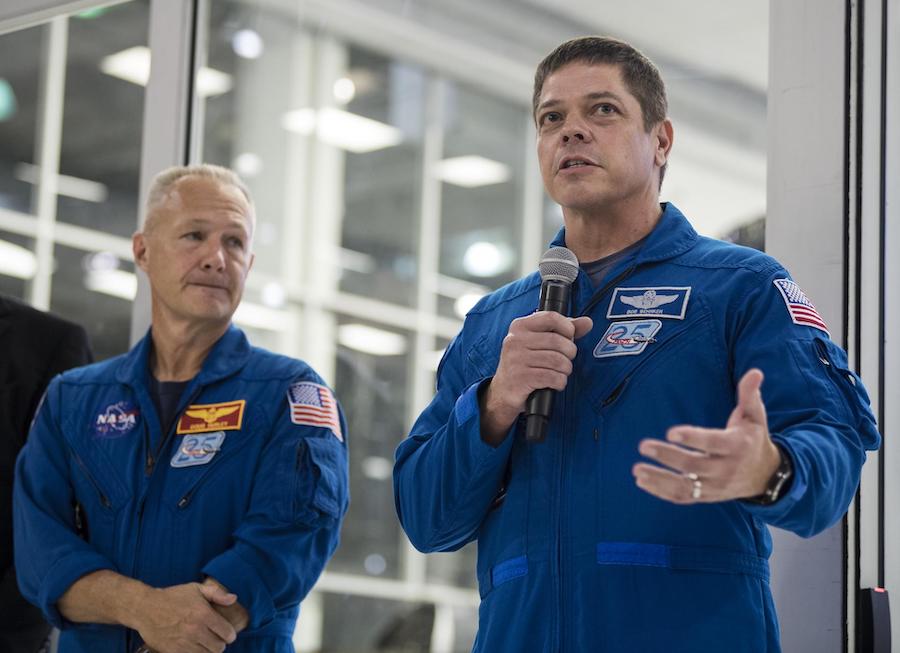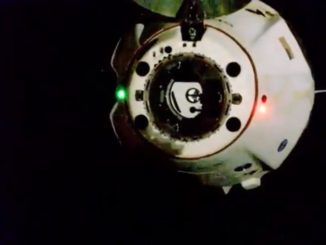
Vice President Mike Pence plans to travel to the Kennedy Space Center on May 27 for the first launch of astronauts from a U.S. spaceport since 2011.
Officials at a meeting of the National Space Council Tuesday said Pence will attend the launch, and a Space Council spokesperson confirmed the plans. Details about Pence’s visit have not been released.
Pence chaired the meeting at NASA Headquarters in Washington, with presentations by Cabinet members, military and intelligence officials, and NASA Administrator Jim Bridenstine, who joined the council virtually from the Johnson Space Center in Houston.
Astronauts Doug Hurley and Bob Behnken also spoke with Pence from Houston via video conference. The astronauts are scheduled to fly to the Kennedy Space Center in Florida on Wednesday aboard a NASA Gulfstream jet for the final week before launch.
Liftoff is scheduled for 4:33 p.m. EDT (2033 GMT) from pad 39A at the Kennedy Space Center. The last time a crew headed for space from the Florida spaceport was July 8, 2011, when the space shuttle Atlantis rocketed into orbit from the same launch pad.
Pence told the astronauts Tuesday that their mission “comes at important time in the life of our nation” as the coronavirus pandemic affects lives across the United States, and the world.
“It really is a testament to all of you, and all the hands in this program, that even in the midst of a national crisis, NASA stayed on mission and kept doing the work,” Pence told Hurley and Behnken. “I have to tell you that it’s going to be a great inspiration to the country next week to see you two go aloft from the Kennedy Space Center.”
Hurley and Behnken joined the National Space Council meeting virtually Tuesday morning following routine pre-flight medical exams.

“We can’t emphasize enough the amount of hands that have touched this vehicle from start to finish, the folks in the commercial crew program at NASA, the folks out at SpaceX,” said Hurley, the Crew Dragon spacecraft commander. It’s been an incredible journey to get this far, and in some ways it’s really hard to believe we’re going to launch next week, but it’s incredibly exciting.”
Hurley and Behnken entered an enhanced version of NASA’s standard pre-launch quarantine protocol May 13, in which they will be tested twice for the COVID-19 viral disease before their launch May 27. The astronauts are each veterans of two space shuttle missions, and they began training in 2015 for a flight on one of two U.S. crew vehicles developed by SpaceX and Boeing.
They were assigned to the first piloted Crew Dragon mission in 2018.
“Doug and I have both spent years in the as astronaut office going through the process of launching American astronauts on Russian Soyuz, and we are really excited after that experience to bring it back home and share with new classes of astronauts what is it like to launch Americans from American soil,” Behnken said. “We do want the thank the team that worked so hard to continue to press forward with this mission in the face of the challenges with the COVID-19 situation, and we’re both really excited and prepared to pull this off and bring it back home.”
The Russian Soyuz spacecraft has been the exclusive ride to and from the space station for U.S. astronauts since the end of the space shuttle program.
NASA started work on the commercial crew program under the Obama administration in 2010, and the agency says it invested around $5 billion to develop the SpaceX Crew Dragon and Boeing Starliner vehicles. As part of NASA’s requirements for the program, each company also put up some of their own money.
In 2014, NASA selected SpaceX and Boeing to proceed into full-scale development of their commercial crew vehicles.
“To me, dreams begin at NASA,” said Gen. John Hyten, vice chairman of the Joint Chiefs of Staff. “This is where dreams begin in this country. Dreams began for me with NASA because my dad worked on the Saturn 5 back in the 1960s.”
Hyten is a veteran of numerous posts in Air Force space programs. In remarks at Tuesday’s National Space Council meeting, he framed the return of human spaceflight to the United States in the lens of national security
China and Russia continued flying people in orbit after the shuttle’s retirement, “and you could see the momentum building,” Hyten said.
“You see what they started to do form a security perspective, and it was not good,” Hyten said of China and Russia. “And as those challenges started to be put in front of us, we needed to build dreams again, and dreams come when you start flying into space … When you see the X-37 (uncrewed spaceplane) go up, that gets a lot of people’s attention, but when you put an astronaut on top of a rocket and you fly into space, that changes everything.
“Next week when NASA puts astronauts on top of the Falcon 9 and the Dragon capsule and flies into space again, those dreams begin again,” Hyten said.
Behnken and Hurley are scheduled to arrive at the Kennedy Space Center around 4 p.m. EDT (2000 GMT) Wednesday.
NASA and SpaceX officials will convene a Flight Readiness Review on Thursday to go over the technical status of SpaceX’s Falcon 9 rocket, the Crew Dragon capsule, ground systems and the International Space Station.
A press conference with NASA and SpaceX managers is scheduled Thursday evening at the conclusion of the readiness review.
Meanwhile, SpaceX technicians inside a hangar at the southern perimeter of pad 39A at Kennedy are completing connections between the Crew Dragon capsule and the Falcon 9 launcher this week. The fully-assembled rocket, stretching 215 feet (65 meters) tip to tail, is scheduled to roll out to pad 39A later this week for a test-firing.
Follow Stephen Clark on Twitter: @StephenClark1.



